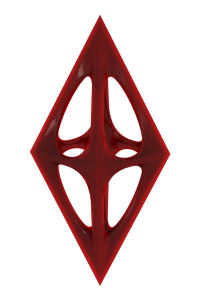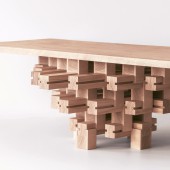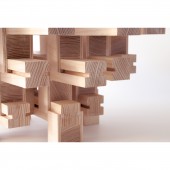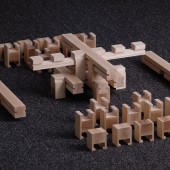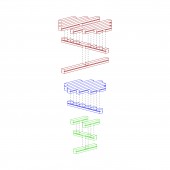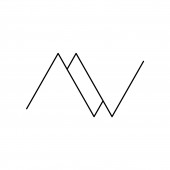Grid Table by Mian Wei |
Home > Winners > #77757 |
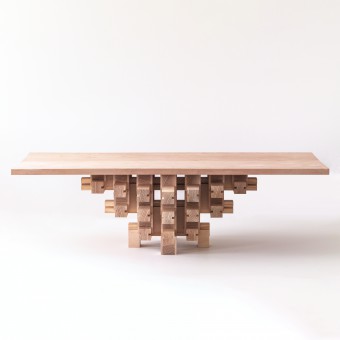 |
|
||||
| DESIGN DETAILS | |||||
| DESIGN NAME: Grid PRIMARY FUNCTION: Table INSPIRATION: The inspiration came from traditional Chinese architecture, where a type of wooden structure called Dougong(Dou Gong) is used in various parts of a building. Dougong is essential to the timber frame structure of traditional Chinese building, as it binds the roof, girders and pillars together to distribute weight evenly. The project sets to improve upon the ancient structure by making it simpler and more suitable for modern life. UNIQUE PROPERTIES / PROJECT DESCRIPTION: By the use of traditional interlocking wood structure, assembly of the table is also the process of learning about the structure and experiencing history. The supporting structure(Dou Gong) is made of modular parts that can be easily disassembled and reassembled in need of storage and moving. The bracket connectors (Gong) slide easily into the beams(Dou) to form the weight bearing structure and retain structural integrity when the table is being lifted, therefore no screw needed. OPERATION / FLOW / INTERACTION: The table has a strong presence in the room. The image might look puzzling at first, but as the owner builds the table, the realization comes that the complex aesthetic of the table grows from the simple and understandable interlocking structure without any decoration or ornamental excess. Through building the table, the complexity fades away, and the sensible nature reveals. The structure itself creates the form and the aesthetic. The table is by itself a different piece of furniture for the guest and the owner. PROJECT DURATION AND LOCATION: The project started in 2015 in China. A prototype was made in 2017 in Rhode Island. It was exhibited in May 2017 in Providence RI. A full scale table was made in 2018 in Massachusetts. FITS BEST INTO CATEGORY: Furniture Design |
PRODUCTION / REALIZATION TECHNOLOGY: The table is made of ash, maple, and plywood. The brackets connectors(Gong) were made first into long beams and then cut to pieces. The brackets then slide in and lock the beams(Dou) made of ash wood. Together the two make the entire structure. Eventually, a maple wood panel is put on top as the surface and supported evenly. The table is highly machine manufacturable and can be mass-produced. SPECIFICATIONS / TECHNICAL PROPERTIES: 1500 mm x 900 mm x 450 mm TAGS: Table, China, Furniture, Modular RESEARCH ABSTRACT: The project started when I was on an architectural road trip across China. There are a large amount of ancient wooden architectural relics scattered across central-northern China, particularly in Shanxi province where I spent the most time. These buildings withstood the test of time and are still standing today. A few of them became prized tourist attractions but most of them remain quietly in the mountains and villages that are mostly unknown to the fast developing outside world. The wooden structure Dougong(Dou Gong) plays an important role in the historical development of Chinese architecture. Dougong serves primarily as a structural element in architecture in early dynasties, used to distribute weight evenly across large architectural volume. In later dynasties, Dougong gradually turned into a decorative element of architecture and serves mainly aesthetic purposes. This project, on the one hand, tries to go back to the root to reinvestigate the practicality and scalability, and bring new life to the ancient tradition. On the other hand, the project seeks to explore new aesthetic possibilities of the structure with modern forms and production techniques. CHALLENGE: The main challenge is to bring a traditional handcrafted structure into the modern age. Simply inheriting an old design is not enough. Many have tried to imitate the ancient aesthetic with wood and rivets or even concrete, but those loose visual interpretations parted its structural nature and simplicity of assembly. The structure and crafting procedure have to be redesigned and reorganized to fit modern life and manufacturing while at the same time retain value, tradition, and physical property. The project seeks to reduce the structure into the simplest modular form while preserving its functional and aesthetic nature. ADDED DATE: 2019-02-21 01:12:33 TEAM MEMBERS (1) : Mian Wei IMAGE CREDITS: Mian Wei PATENTS/COPYRIGHTS: Copyrights belong to Mian Wei, 2019. |
||||
| Visit the following page to learn more: http://mian-wei.com | |||||
| AWARD DETAILS | |
 |
Grid Table by Mian Wei is Winner in Furniture Design Category, 2018 - 2019.· Read the interview with designer Mian Wei for design Grid here.· Press Members: Login or Register to request an exclusive interview with Mian Wei. · Click here to register inorder to view the profile and other works by Mian Wei. |
| SOCIAL |
| + Add to Likes / Favorites | Send to My Email | Comment | Testimonials | View Press-Release | Press Kit | Translations |
Did you like Mian Wei's Furniture Design?
You will most likely enjoy other award winning furniture design as well.
Click here to view more Award Winning Furniture Design.

